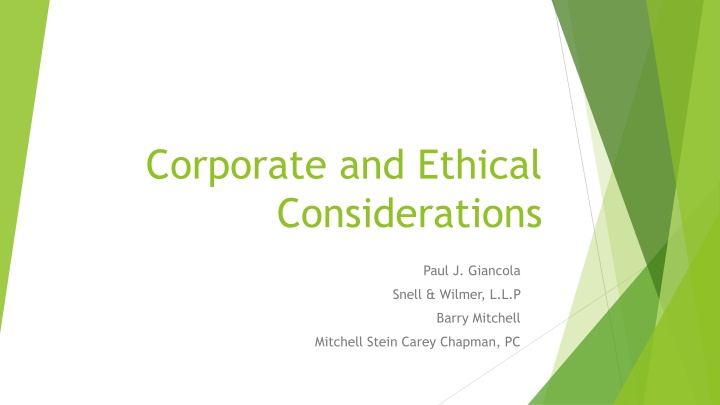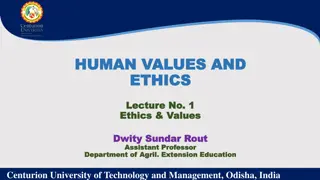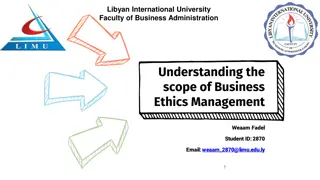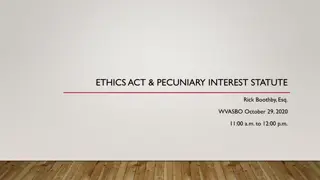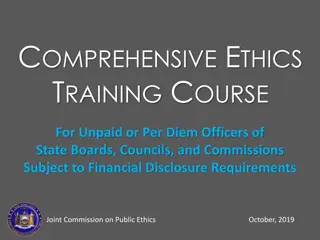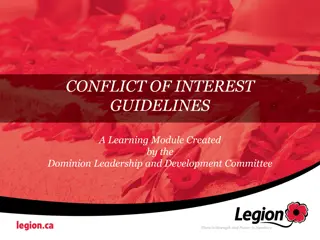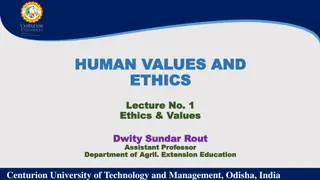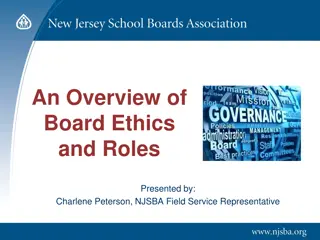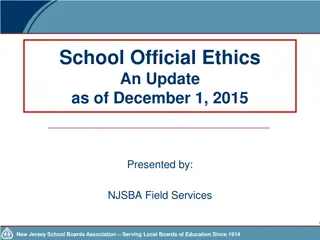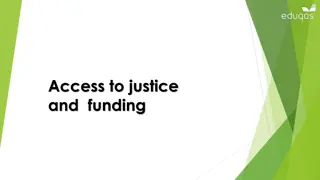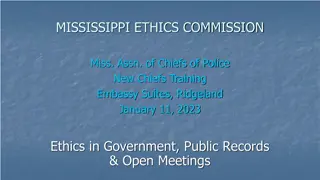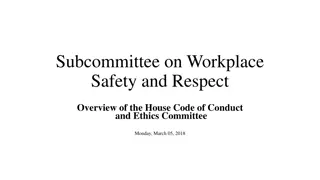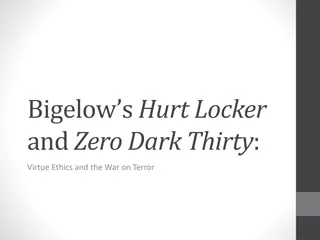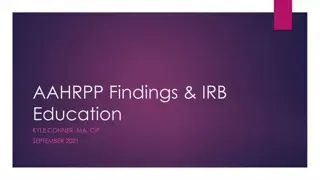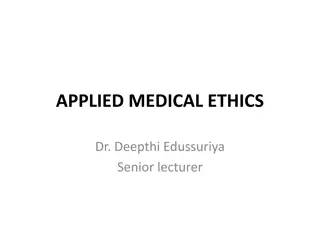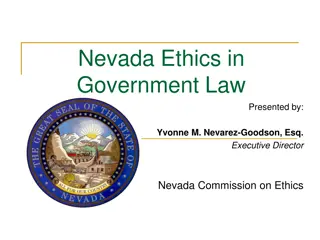Ethics and Conflicts of Interest in Legal Practice
The content discusses key rules related to conflicts of interest in the legal profession, focusing on the obligations of lawyers towards current and former clients. It explains the situations where conflicts may arise, and the conditions under which a lawyer may or may not represent a client in such scenarios. The rules emphasize the importance of informed consent and diligent representation to ensure ethical conduct in the legal field.
Uploaded on Sep 26, 2024 | 2 Views
Download Presentation

Please find below an Image/Link to download the presentation.
The content on the website is provided AS IS for your information and personal use only. It may not be sold, licensed, or shared on other websites without obtaining consent from the author.If you encounter any issues during the download, it is possible that the publisher has removed the file from their server.
You are allowed to download the files provided on this website for personal or commercial use, subject to the condition that they are used lawfully. All files are the property of their respective owners.
The content on the website is provided AS IS for your information and personal use only. It may not be sold, licensed, or shared on other websites without obtaining consent from the author.
E N D
Presentation Transcript
Corporate and Ethical Considerations Paul J. Giancola Snell & Wilmer, L.L.P Barry Mitchell Mitchell Stein Carey Chapman, PC
Rule 1.7: Conflict of Interest: Current Clients Client-Lawyer Relationship (a) Except as provided in paragraph (b), a lawyer shall not represent a client if the representation involves a concurrent conflict of interest. A concurrent conflict of interest exists if: (1) the representation of one client will be directly adverse to another client; or (2) there is a significant risk that the representation of one or more clients will be materially limited by the lawyer's responsibilities to another client, a former client or a third person or by a personal interest of the lawyer. (b) Notwithstanding the existence of a concurrent conflict of interest under paragraph (a), a lawyer may represent a client if: (1) the lawyer reasonably believes that the lawyer will be able to provide competent and diligent representation to each affected client; (2) the representation is not prohibited by law; (3) the representation does not involve the assertion of a claim by one client against another client represented by the lawyer in the same litigation or other proceeding before a tribunal; and 2 (4) each affected client gives informed consent, confirmed in writing.
Rule 1.9: Duties to Former Clients Client-Lawyer Relationship (a) A lawyer who has formerly represented a client in a matter shall not thereafter represent another person in the same or a substantially related matter in which that person's interests are materially adverse to the interests of the former client unless the former client gives informed consent, confirmed in writing. (b) A lawyer shall not knowingly represent a person in the same or a substantially related matter in which a firm with which the lawyer formerly was associated had previously represented a client (1) whose interests are materially adverse to that person; and (2) about whom the lawyer had acquired information protected by Rules 1.6 and 1.9(c) that is material to the matter; unless the former client gives informed consent, confirmed in writing. (c) A lawyer who has formerly represented a client in a matter or whose present or former firm has formerly represented a client in a matter shall not thereafter: (1) use information relating to the representation to the disadvantage of the former client except as these Rules would permit or require with respect to a client, or when the information has become generally known; or (2) reveal information relating to the representation except as these Rules would permit or require with respect to a client. 3
Rule 1.10: Imputation of Conflicts of Interest: General Rule Client-Lawyer Relationship (a) While lawyers are associated in a firm, none of them shall knowingly represent a client when any one of them practicing alone would be prohibited from doing so by Rules 1.7 or 1.9, unless (1) the prohibition is based on a personal interest of the disqualified lawyer and does not present a significant risk of materially limiting the representation of the client by the remaining lawyers in the firm; or 4
Rule 1.10: Imputation of Conflicts of Interest: General Rule cont d Client-Lawyer Relationship (2) the prohibition is based upon Rule 1.9(a) or (b) and arises out of the disqualified lawyer s association with a prior firm, and (i) the disqualified lawyer is timely screened from any participation in the matter and is apportioned no part of the fee therefrom; (ii) written notice is promptly given to any affected former client to enable the former client to ascertain compliance with the provisions of this Rule, which shall include a description of the screening procedures employed; a statement of the firm's and of the screened lawyer's compliance with these Rules; a statement that review may be available before a tribunal; and an agreement by the firm to respond promptly to any written inquiries or objections by the former client about the screening procedures; and (iii) certifications of compliance with these Rules and with the screening procedures are provided to the former client by the screened lawyer and by a partner of the firm, at reasonable intervals upon the former client's written request and upon termination of the screening procedures. 5
Rule 1.10: Imputation of Conflicts of Interest: General Rule cont d Client-Lawyer Relationship (b) When a lawyer has terminated an association with a firm, the firm is not prohibited from thereafter representing a person with interests materially adverse to those of a client represented by the formerly associated lawyer and not currently represented by the firm, unless: (1) the matter is the same or substantially related to that in which the formerly associated lawyer represented the client; and (2) any lawyer remaining in the firm has information protected by Rules 1.6 and 1.9(c) that is material to the matter. (c) A disqualification prescribed by this rule may be waived by the affected client under the conditions stated in Rule 1.7. (d) The disqualification of lawyers associated in a firm with former or current government lawyers is governed by Rule 1.11. 6
Joint Representation Issues Scope of representation defined Defense of qui tam action Practice separation Multiple employees/shareholders Informed Consent Prospective waiver of conflicts of interest Representation of existing or new clients in any matter not substantially related to the matter we are handling on your behalf Even if the interests of such other client(s) in those other matters are directly adverse to yours Including litigation 7
Joint Representation Issues contd Joint representation wavier Benefits Common position Reduce legal costs Adverse positions or interests develop Resolve without counsel Unresolved conflict Withdrawal of counsel Exclude representation of and issues Representation of some or one may continue 8
Joint Representation Issues contd Limitations Equally share information May not withhold information Cannot provide advice with respect to rights or obligations of the other Personal lawyer may advise you differently on the matter Impact on attorney-client privilege Not privileged among clients, only as to third parties May not use confidential information obtained in joint representation to the disadvantage of a client who is no longer represented 9
Yates Memorandum Issued September 9, 2015, by DAG Sally Q. Yates Formally Titled Individual Accountability for Corporate Wrongdoing All or Nothing Approach to Cooperation Credit 10
Yates Memo issued to: Antitrust Division Civil Division Criminal Division Environmental and Natural Resources Division National Security Division Tax Division FBI All 94 United States Attorneys Offices 11
Yates Memo: Six Key Points 1. To qualify for cooperation credit, corporations must provide to DOJ all relevant facts relating to individuals responsible for the misconduct; 2. Criminal and civil corporate investigations should focus on individuals from the beginning; 3. Criminal and civil attorneys should be in routine communication with one another; 12
Yates Memo: Six Key Points contd 4. DOJ will not release culpable individuals from civil or criminal liability when resolving a matter with a corporation (absent extraordinary circumstances); 5. DOJ attorneys should not resolve matters with corporations without a plan to resolve individual cases; and 6. Civil attorneys should focus on individuals and companies based on considerations beyond an individual s ability to pay. 13
Changes to Yates Memo Rosenstein Speech 11/29/18 All individuals substantially involved in or responsible for the misconduct Company must act in good faith to identify those individuals Must identify all wrongdoing by senior officials (management and Board) Who authorized What they knew about it DOJ can now negotiate releases for individuals who do not warrant additional investigation 14
Yates Memo: Impacts on Internal Investigations Enhanced Upjohn warnings Increased tension between corporations and its executives Retention of individual counsel Who needs it Yates binders Which employees qualify as substantially involved in or responsible for the misconduct ? Increased demands for cooperation clauses in settlement agreements Internal investigations will continue after corporate settlements 15
Ethical Obligations During Investigation Who does corporate counsel represent Advice regarding what information to provide in course of cooperation Resolution of corporate and individual liability How to handle parallel civil and criminal investigations 16
Ethical Obligations During Investigation How to protect privileged communications Attorney work product doctrine Use of joint defense agreements 17
Joint Defense Agreements (JDAs) JDA s are based on the common interest doctrine, which extends the attorney-client privilege It allows parties to share information with each other without worry of waiving the attorney-client privilege Common interest means shared or similar, not identical JDA s can be written or verbal The label Joint Defense Agreement is misnomer and often confuses clients The common interest the doctrine can be applied to non- litigation settings, such as transactional communications 18
Joint Defense Agreements Challenges, Conflicts and Concerns In criminal cases, a lawyer must anticipate a co-defendant will ultimately cooperate with the government Defense counsel, however, refused to explore those contradictions through cross-examination for fear of violating the JDA. His client was convicted. What happens if your client and another member of JD group become adverse in litigation? One concern is waiver of the attorney-client privilege. If a court decides that you represented the entire group, then your client may have waived the privilege as it pertains to future actions with other group members. 19
Joint Defense Agreement Challenges and Concerns Courts can exercise supervisory powers over JDA s to serve the interests of justice. For example, a court can order counsel to submit their proposed JDA to the court for in camera review. There will be instances when a co-defendant attempts to monopolize the direction of legal strategy under a JDA solely to benefit herself Many clients can t grasp their scope. For example, they insist on having conversations with co-defendants outside the presence of their lawyers. 20
Joint Defense Agreement Challenges and Concerns cont d Even hallway discussions in lawyers offices are not privileged and can be used as evidence against the participants. See United States v. Krug, where a written JDA was entered into by co-defendants and their lawyers. Co- defendants had a hallway discussion about case issues. The Court ruled the yapping was not protected by the JDA: The mere fact that the communications were among co- defendants who had joined in a joint defense agreement was, without more, insufficient to protect the statements from disclosure. Lawyers must be concerned about actions that might create an attorney-client relationship 21
Joint Defense Agreements Conflicts and Concerns The Court can decide the JDA does not exist A lawyer has a duty of confidentiality to the JDA s parties, not just her client implied attorney-client relationship fiduciary duty ER 1.10: in-house counsel s conflict can be imputed and lead to disqualification of the entire legal department ER 1.9: JDA s can create conflicts concerning the representation of former client stemming from a duty of confidentiality created by a Joint Defense Agreement exists where: Confidential information exchanged Former representation is the same/substantially related to the pending litigation Current client s interests materially adverse to the interests of the party claiming protection under the JDA 22
Bullet Proof JDAs Dont Exist (But, If Youre Putting it in Writing), Give it a Shot: Disclaim any actual attorney-client relationship between an attorney and client other than the pre-existing client of that attorney, and that no such relationship will arise by implication (Important to avoid future waiver of privilege) Make a clear statement of no duty of loyalty owed to anyone other than lawyer s client Waive of the right to seek the disqualification of lawyer members based on access to JD materials Waive the right to object to member lawyers acting adversely towards one another 23
Bullet Proof JDAs Dont Exist Describe how the JDA may be used by the group members and their counsel State clearly that sharing JD materials is in the parties' common interest and necessary for lawyers to optimally represent their clients Implement an ethical screen limiting document access to lawyers working on the file Include an avowal that all member lawyers have performed thorough conflict checks Describe the necessary steps for clients and lawyers to withdraw from the JDA; focus on notice 24
Settlement Negotiations The Players OIG DOJ (Local U.S. Attorney s Office and Main Justice) Criminal AUSA Civil AUSA Relators & Counsel Individuals (civil and criminal) Corporations (Board of Directors/Special Committees) 25
Anticipating Regulatory/Enforcement Action and Litigation COMPLIANCE PROGRAMS RESPONSE PLANS COMMUNICATION HABITS 26
Communications Habits When representing client as an individual, remind client to use person/non-work email (if she must use email) Advise client to act and speak as if she is broadcasting when she is anywhere outside her home Texting is not secure and is a crappy way to communicate about legal issues 27
Response Plan Always be polite and courteous. Do not volunteer information. Contact the senior level individual designated to handle inquiries by government agents. Contact the provider s lawyer immediately. If contacted on the telephone by a government agent, confirm the agent s name, agency, phone number and the purpose for the contact; tell the agent the provider s lawyer will contact him or her. 28
Response Plan contd If the agent presents a search warrant or other mechanism (e.g., justifiable demand for access at time of request by OIG or MFCU) allowing the agent immediate access to the provider s documents and materials, the search warrant should be photocopied; verify the authenticity of the search warrant by calling the applicable agency or issuing judge; the agent must be escorted by senior level personnel during the search. During the search of documents or materials conducted under a search warrant or other mechanism giving the agent immediate access to the provider, the designated senior level individual should make note of everything that happens during the inspection (i.e., every location inspected or visited by the agent, all questions asked by the agent and all answers or information provided to the agent). 29
Response Plan contd Copies should be made of all documents to be inspected or copied by the agent. Do not destroy, lose or alter any document. Be aware that individuals have the right to speak, or not to speak, with government agents; they have the right to be represented by counsel; and the provider will seek its lawyer present at all interviews. 30
Response Plan (contd) If an agent appears unannounced at the provider s premises, politely decline access and ask for the agent s card so the provider s lawyer may contact the agent. Be aware that an entity that fails to grant immediate access to a facility, or to records or documents, upon reasonable request by the Department of Health and Human Services, Medicare State Agencies, the Office of the Inspector General ( OIG ), or State Medicare Fraud Control Units ( MFCU ) may be excluded from the Medicare program. A reasonable request is defined as a written request made by a properly unidentified agent. Immediate access under the Medicare statutes and regulations means within 24 hours. The OIG or MFCU can demand access at the time of the request if there is reason to believe that documents are about to be altered or destroyed. 31
Compliance Program Objectives OBJECTIVE ONE agents that are reasonably capable of reducing the prospect of immigration violations and related wrongdoing currently, retrospectively, and prospectively; Establish compliance standards and procedures for employees and OBJECTIVE TWO company s compliance; Assign specific high-level Company individuals to oversee the OBJECTIVE THREE discretionary authority to individuals whom the Company knows or should know, through the exercise of due diligence, have a propensity to engage in illegal immigration activities; Exercise due care to prevent delegation of substantial OBJECTIVE FOUR procedures concerning immigration and employment issues to all employees and agents through, for example, mandatory training programs or dissemination of written materials that explain the requirements; Take steps to communicate the Company s standards and 32
Compliance Program Objectives contd OBJECTIVE FIVE auditing systems that are reasonably designed to detect criminal conduct or other wrongdoing related to immigration and worker issues, and create and publicize a reporting system which adequately insulates those who raise concerns from fear of retaliation; Take reasonable steps to achieve compliance e.g., monitoring and OBJECTIVE SIXConsistently enforce the prevention/detection program through appropriate mechanisms, including discipline of individuals responsible for failing to detect an offense; and OBJECTIVE SEVEN detected offense and to prevent future recurrences, including, if necessary, modifying the prevention/detection program. Take all reasonable steps necessary to respond appropriately to a 33
Compliance Program Benefits A compliance program is beneficial because it will: reduce the risk of civil and criminal wrongdoing in the company setting, and dramatically reduce financial penalties if violations occur; create a mechanism to detect violations and problems before they start and often before government regulators discover them; reduce vulnerability to employee "whistle-blowing" and attendant liabilities and establish a crisis response plan that improves the ability of the Company to respond quickly and positively to regulatory filings, lawsuits and investigations; establish a structure to preserve the right of confidentiality under the attorney/client privilege for all internal investigations and compliance activities by the Company; 34
Compliance Program Benefits contd A compliance program is beneficial because it will: provide additional objective sources of information to the Company on how the Company is actually functioning; provide assurance to the business community that the Company is proactive concerning compliance issues; improve internal communication and feedback to the Company regarding issues; establish a structure to ensure that legal and policy changes are disseminated quickly and compellingly to all employees; and be tax deductible; the cost of implementing a compliance program a compliance officer's salary, a hotline, hiring a consultant to help with the plan are all tax-deductible as regular business expenses. 35
Thank You Paul J. Giancola, Partner Health Care and Compliance 602.382.6324 | pgiancola@swlaw.com www.swlaw.com/blog/data-security Barry Mitchell, Partner 602.385.0293 | barry@MSCCLaw.com 36
